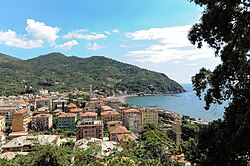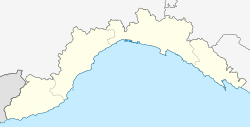Levanto, Liguria
Levanto
Lievanto (Ligurian) | |
|---|---|
| Comune di Levanto | |
 | |
| Coordinates: 44°10′N 9°37′E / 44.167°N 9.617°E | |
| Country | Italy |
| Region | Liguria |
| Province | La Spezia (SP) |
| Frazioni | Lizza, Lavaggiorosso, Dosso, Groppo, Montale, Vignana, Lerici, Pastine, Chiesanuova, Fontona, Legnaro, Fossato, Ridarolo |
| Government | |
| • Mayor | Maurizio Moggia |
| Area | |
| • Total | 38.0 km2 (14.7 sq mi) |
| Elevation | 4 m (13 ft) |
| Population (31 December 2008)[2] | |
| • Total | 5,597 |
| • Density | 150/km2 (380/sq mi) |
| Demonym | Levantesi |
| Time zone | UTC+1 (CET) |
| • Summer (DST) | UTC+2 (CEST) |
| Postal code | 19015 |
| Dialing code | 0187 |
| Website | Official website |
Levanto (Italian: [ˈlɛːvanto]; Ligurian: Lévanto [ˈlevaŋtu] or Levanto [leˈvaŋtu], locally Lievanto [ljeˈvaŋtu]) is a comune (municipality) in the province of La Spezia, in the Italian region of Liguria, located almost 90 kilometres (56 mi) southeast of Genoa and about 20 kilometres (12 mi) northwest of La Spezia.
The town is on the coast at the mouth of a river valley, between hills thickly wooded with olive and pine trees. The ridges on either side of the valley thrust out into the sea as the headlands of Mesco and Levanto. The municipality forms part of the coastal district known as the Comunità Montana della Riviera Spezzina, and part of its territory is included in the Cinque Terre National Park.
History
[edit]In Roman times there was already a small settlement there by the name of Ceula, an important nodal point due to its location and harbour. At the beginning of the 9th century, the bell tower of the present church, the Chiesa di San Siro, served as a watchtower and as a defence against dangers from the sea. From the 13th century, however, the importance of the area began to decline – this was to the advantage of Levanto itself, which was expanding by the sea.
Levanto first became the feudal stronghold of the Malaspina, before passing to the Da Passano and then, in 1229, to the Republic of Genoa. In the Middle Ages, the village became a centre of commercial activity, benefiting from maritime and overland travel, the most important of the latter routes being the Via Francigena, the ancient pilgrims' way that in medieval times connected Canterbury to Rome. In the post-Medieval period, the village saw major development with the construction of the Borgo Nuovo or Stagno, largely completed by the 17th century, on the plain of the small river Ghiararo. This area is characterised by interesting painted 17th and 18th-century houses, some built on much earlier buildings. A further phase of urban development took place at the turn of the 19th and 20th centuries with the opening of two new thoroughfares, the present Corso Italia and Corso Roma. From 1950, the village experienced further growth, culminating during the 1970s in the present townscape.
Main sights
[edit]- Medieval castle, built to defend the village and still in a state of perfect conservation. Privately owned and not open to the public.
- Church of Sant'Andrea (Church of Saint Andrew). An example of 13th-century Ligurian Gothic style with its façade decorated in black and white stripes, and a magnificent rose window surmounting the main door. The chalice of emperor Henry VII is one of its treasures, and displayed only on special occasions such as the festival of the patron saint.
- Church of Santa Maria della Costa (Church of Saint Mary of the Coast). Pre-13th century.
- Villa Agnelli. Its gardens were landscaped at the beginning of the 20th century. Privately owned and not open to the public.
- Piazza della Loggia, characterised by a 13th-century loggia, which in 2007 received from UNESCO the title of "monument being evidence of culture and peace".
- Piazza Cavour, in earlier times the inner courtyard of the Monastero delle Ordine di Santa Chiara (Monastery of the Order of St Clare, the Poor Clares), dating from the 16th century. Their former convent now accommodates the town hall, the small public library and other municipal offices.
Transport
[edit]Levanto station is a stop on the Genoa–Pisa railway, and is the westernmost station for tourist trains serving the villages of the Cinque Terre.
Culture
[edit]- Permanent exhibition of cultural artefacts, in a 14th-century building attached to hostel Ospitalia del Mare.
Festivals
[edit]- Amfiteatrof Music Festival: classical and chamber music festival dedicated to Russian-born cellist Massimo Amfiteatrof, in June/July – September[3]
- Festa di San Giacomo (Feast of St James) and Festa del Mare (Festival of the Sea), 24–25 July[4]
- Festa di Nostra Signora della Guardia: traditional band concert, 29 August
- Sagra del Gattafin (fried pastry stuffed with beets, onions, egg and grated cheese), in June
- Festa Madonna del Soccorso, 1–2 July in Fontona (a little village near Levanto)

References
[edit]- ^ "Superficie di Comuni Province e Regioni italiane al 9 ottobre 2011". Italian National Institute of Statistics. Retrieved 16 March 2019.
- ^ "Popolazione Residente al 1° Gennaio 2018". Italian National Institute of Statistics. Retrieved 16 March 2019.
- ^ Festival Massimo Amfiteatrof official website
- ^ "La festa del mare". Comune di Levanto. Retrieved 12 October 2021.




